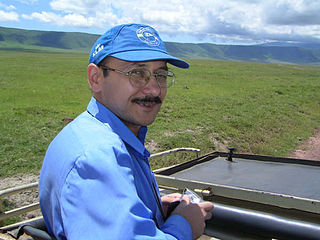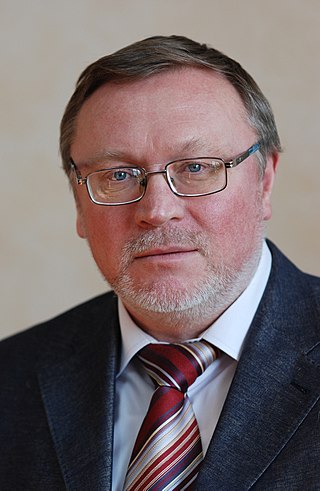A hierarchy is an arrangement of items that are represented as being "above", "below", or "at the same level as" one another. Hierarchy is an important concept in a wide variety of fields, such as architecture, philosophy, design, mathematics, computer science, organizational theory, systems theory, systematic biology, and the social sciences.
A hierarchical organization or hierarchical organisation is an organizational structure where every entity in the organization, except one, is subordinate to a single other entity. This arrangement is a form of a hierarchy. In an organization, the hierarchy usually consists of a singular/group of power at the top with subsequent levels of power beneath them. This is the dominant mode of organization among large organizations; most corporations, governments, criminal enterprises, and organized religions are hierarchical organizations with different levels of management, power or authority. For example, the broad, top-level overview of the general organization of the Catholic Church consists of the Pope, then the Cardinals, then the Archbishops, and so on.
Systems theory is the transdisciplinary study of systems, i.e. cohesive groups of interrelated, interdependent components that can be natural or artificial. Every system has causal boundaries, is influenced by its context, defined by its structure, function and role, and expressed through its relations with other systems. A system is "more than the sum of its parts" by expressing synergy or emergent behavior.

An organization or organisation, is an entity—such as a company, an institution, or an association—comprising one or more people and having a particular purpose.

The following outline is provided as an overview of and topical guide to academic disciplines:
A chiefdom is a form of hierarchical political organization in non-industrial societies usually based on kinship, and in which formal leadership is monopolized by the legitimate senior members of select families or 'houses'. These elites form a political-ideological aristocracy relative to the general group.

Dmitri Mikhailovich Bondarenko is a Russian anthropologist, historian, and Africanist. He has conducted field research in a number of African countries and among Black people in Russia and the United States. He is Principal Research Fellow and Vice-Director for Research with the Institute for African Studies of the Russian Academy of Sciences, Director of the International Center of Anthropology of the HSE University, and Full Professor in Ethnology with the Center of Social Anthropology of the Russian State University for the Humanities. He holds the titles of Professor in Ethnology from the Lomonosov Moscow State University, Professor of the Russian Academy of Sciences in Global Problems and International Relations, and Corresponding Member of the Russian Academy of Sciences in History.

A database model is a type of data model that determines the logical structure of a database. It fundamentally determines in which manner data can be stored, organized and manipulated. The most popular example of a database model is the relational model, which uses a table-based format.
A glossary of terms relating to systems theory.
The model of hierarchical complexity (MHC) is a framework for scoring how complex a behavior is, such as verbal reasoning or other cognitive tasks. It quantifies the order of hierarchical complexity of a task based on mathematical principles of how the information is organized, in terms of information science. This model was developed by Michael Commons and Francis Richards in the early 1980s.
Michael Lamport Commons is a theoretical behavioral scientist and a complex systems scientist. He developed the model of hierarchical complexity.

Nikolay Nikolaevich Kradin is a Russian anthropologist and archaeologist. Since 1985 he has been a Research Fellow of the Institute of History, Archaeology and Ethnology, Far East Branch of the Russian Academy of Sciences in Vladivostok. He was Head and Professor of the Department of Social Anthropology in the Far-Eastern National Technical University, and also Head and Professor of the Department of World History, Archaeology and Anthropology in the Far-Eastern Federal University. Corresponding Member of the Russian Academy of Sciences since 2011 and full Member of the Russian Academy of Sciences since 2022.
Homoarchy is "the relation of elements to one another when they are rigidly ranked one way only, and thus possess no potential for being unranked or ranked in another or a number of different ways at least without cardinal reshaping of the whole socio-political order."
Homeokinetics is the study of self-organizing, complex systems. Standard physics studies systems at separate levels, such as atomic physics, nuclear physics, biophysics, social physics, and galactic physics. Homeokinetic physics studies the up-down processes that bind these levels. Tools such as mechanics, quantum field theory, and the laws of thermodynamics provide the key relationships. The subject, described as the physics and thermodynamics associated with the up down movement between levels of systems, originated in the late 1970s work of American physicists Harry Soodak and Arthur Iberall. Complex systems are universes, galaxies, social systems, people, or even those that seem as simple as gases. The basic premise is that the entire universe consists of atomistic-like units bound in interactive ensembles to form systems, level by level, in a nested hierarchy. Homeokinetics treats all complex systems on an equal footing, animate and inanimate, providing them with a common viewpoint. The complexity in studying how they work is reduced by the emergence of common languages in all complex systems.
A graph database (GDB) is a database that uses graph structures for semantic queries with nodes, edges, and properties to represent and store data. A key concept of the system is the graph. The graph relates the data items in the store to a collection of nodes and edges, the edges representing the relationships between the nodes. The relationships allow data in the store to be linked together directly and, in many cases, retrieved with one operation. Graph databases hold the relationships between data as a priority. Querying relationships is fast because they are perpetually stored in the database. Relationships can be intuitively visualized using graph databases, making them useful for heavily inter-connected data.
Bounded emotionality is a communications studies approach to dealing with emotional control in the workplace. Emotional control simply refers to how employers and employees handle the range of emotions that naturally occur in the workplace. These emotions can occur because of work, or they can be brought into work from an employee's home life. Bounded emotionality was proposed by Dennis K. Mumby and Linda Putnam.
Order, ORDER or Orders may refer to:

A social network is a social structure made up of a set of social actors, sets of dyadic ties, and other social interactions between actors. The social network perspective provides a set of methods for analyzing the structure of whole social entities as well as a variety of theories explaining the patterns observed in these structures. The study of these structures uses social network analysis to identify local and global patterns, locate influential entities, and examine network dynamics.

Produsage is a portmanteau of the words production and usage, coined by German-Australian media scholar Axel Bruns and popularized in his book Blogs, Wikipedia, Second Life and Beyond: From Production to Produsage. Produsage is the type of user-led content creation that takes place in a variety of online environments, open source software, and the blogosphere. The concept blurs the boundaries between passive consumption and active production. The distinction between producers and consumers or users of content has faded, as users play the role of producers whether they are aware of this role or not. The hybrid term produser refers to an individual who is engaged in the activity of produsage. This concept is similar and related to commons-based peer production, a term coined by Yochai Benkler.

Blockmodeling is a set or a coherent framework, that is used for analyzing social structure and also for setting procedure(s) for partitioning (clustering) social network's units, based on specific patterns, which form a distinctive structure through interconnectivity. It is primarily used in statistics, machine learning and network science.